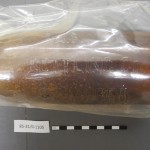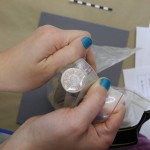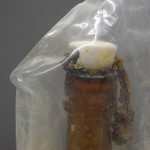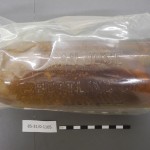Hi everyone!
We have an exciting update on the very first results from the Market Street Chinatown Archaeology Project’s Glass Bottle Residue Pilot Project.
In January, the project shipped 15 glass bottles (of different shapes and sizes) that at one time likely contained beer, liquor, Euro-American patent medicines, traditional Chinese medicines, personal hygiene or grooming products. Many of these bottles are of distinctive shapes associated with certain types of products (see here for examples), while some are embossed with the name of the either the manufacturer, the name of the product it contained, and/or the purveyor, all of which (with the help of guides or archival research) can provide clues as to what the bottle contained at the time of its purchase and use.
However, what do we do when we have a glass bottle, but no embossing or mark? What if the vessel form does not provide clues as to what it held? Even when we have embossing and information on what the bottle contained at the start of its circulation within the Market Street Chinatown, how can we find out what exactly those products were made from? Finally, when emptied of their original contents, how can we find out if these bottles were reused for different purposes than they were made to fulfill?
One way of addressing these questions is through various forms of residue analysis employed by archaeological scientists! In January, Marguerite De Loney, a Stanford PhD student in Archaeology working with the project, pulled 15 glass bottles from the Market Street collection with some type of residue -sometimes powdery, sometimes liquid- still inside of them. These bottles were sent to the University of Idaho Department of Analytical and Environmental Chemistry, where Dr. Ray von Wandruszka and collaborators are carrying out a pilot analysis project of the residues in these bottles in order to identify what was in them, and/or how they were being used at the time of their disposal.
While this project is just getting started, we have some preliminary results on the contents of one large, brown bottle (see pictures below). As you can tell from the photos, the bottle is embossed with “San Jose Bottling Co. C. Maurer.”
- Embossing visible: "San Jose Bottling Co./ C. Maurer"
- Porcelain closure still in place!
- Still holding after at least 126 years!
- Embossing visible: "San Jose Bottling Co."
Documentary research by Dr. von Wandruszka has determined that it is likely a beer bottle, made for the Fredericksburg Brewery of San Jose (1867-1918; see here and here for blog posts about the history of this brewery) by C. Maurer (later C. Maurer and Sons) San Jose Bottling, Co. (see here for PDF of 1905 San Jose Directory that lists C. Maurer and Sons Bottling Company).
This is where things get REALLY interesting: As you can tell from the photos, the bottle still has its original, resealable porcelain closure in place. What you CAN’T tell from the photos, is that this bottle contained a decent amount of thick, slightly cloudy, viscous fluid that was contained by the closure and preserved for at least 126 years! Could this be the last unwanted sip of a historic San Jose local brew?!
Well, not exactly. Dr. von Wandruszka sampled this fluid and determined a few things: It’s combustible, soluble in hexane, and infrared spectroscopy analysis (one of the best analytical techniques for organic residues of this type) has determined that it is made up of fatty acids and/or esters. In other words, this fluid is NOT beer but most likely cooking fat! While they are still trying to determine if it is vegetable or animal fat (they are betting on animal fat), what is clear is that someone at the Market Street acquired this bottle, possibly drank its contents, and then kept it and its useful resealable closure around as a way to store leftover cooking fat rendered from pork or other meats prepared in the kitchen!
These early results really bring home the point that archaeological sciences, in tandem with documentary research can provide us with a much more complete picture of the way in which everyday things were acquired, used, and re-used by the inhabitants of the Market Street Chinatown. It forces archaeologists to consider the extended lifecycles of common (but durable and useful) things like bottles and stoneware food storage vessels that may have been put to creative uses long after their original contents (be it beer, wine or pickled foods) were gone.
Now THIS is how you start a pilot project out with a bang! Stay tuned for more updates and thanks for reading!
Thanks to Dr. Ray von Wandruszka and Dr. Barbara Voss for contributing the content for this post.



